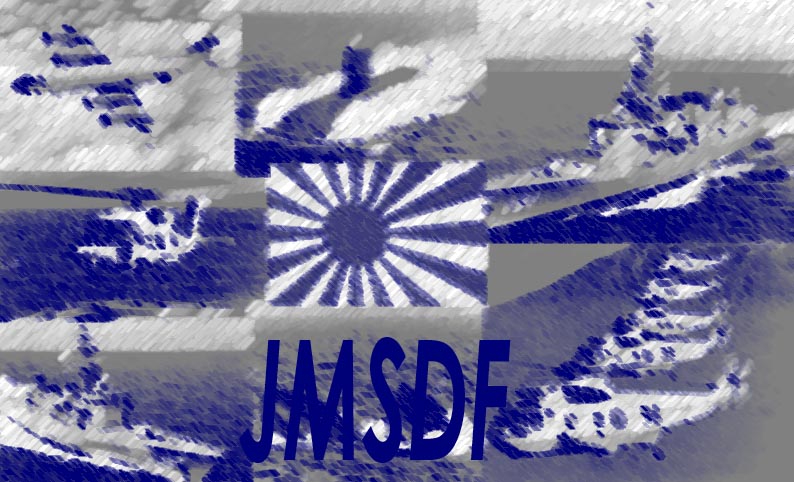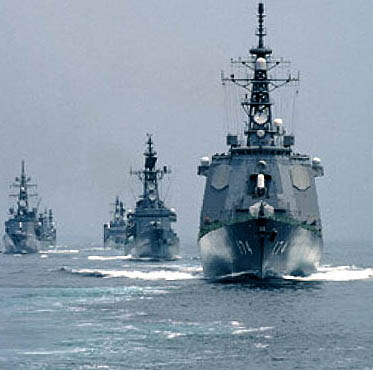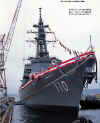
| Two kinds of operations are conducted by the Japan Maritime
Self Defence Force [JMSDF] for the purpose of defending Japan: securing
maritime traffic and securing Japanese territory. For Japan, which relies
on foreign countries for the supply of almost all energy and food, the
influence to national life is quite serious in case that maritime traffic
is cut off. It can also be said that the impact to the world economy is
significant in such case. Therefore, the JMSDF must be able to secure
maritime traffic against attack by enemy submarines, surface ships and
aircraft by effectively combining each operation such as surveillance,
escort and defense of ports and straits. |
 |
Japanese concerns about its neighbour have been heightened
by the increase in the number of incursions into its Exclusive Economic
Zone by Chinese naval vessels. According to Japan's Defence Agency, 31
Chinese military ships were sighted in Japanese waters during 2000,
compared with the one or two of previous years. That these operations
probably involved hydrographic and oceanographic survey of the region is a
firm indication that submarine operations may follow. This serves to
confirm in Japanese minds that, notwithstanding anxieties about North
Korea's ballistic missile capability, China represents its primary
security threat. But self-defence is not confined to home waters. Japan
also has an interest in preserving its trade routes through the Malacca
Straits to the Gulf. For this reason the Japanese Maritime Self-Defence
Force (JMSDF), while still constrained by the Japanese post-war
constitution, continues to explore the limits of what is allowed and
accepted. |
| A highly significant development was the announcement that
a new class of 13,000 ton destroyers would be aviation-capable and
possibly of `through-deck' design. The `Oosumi' class amphibious
ships already have some aircraft carrier characteristics. Underwater, the
quality of a force of 17 active submarines is being improved by the
commissioning of the `Oyashio' class diesel submarines which may form the
testbed for the fitting of air-independent propulsion in a future class.
Improvements to the substantial surface fleet are being achieved by the
introduction of the capable `Improved Murasame' class destroyers while the
acquisition of air-to air refuelling aircraft opens up the possibility of
land-based air defence aircraft operating in its support. The principal
air defence platforms, the `Kongou' class, are based on the USN `Arleigh
Burke' class and may also form the basis for the next step in the
development of the rapidly expanding and increasingly sophisticated JMSDF. |
JMSDF Fleet :
Surface Combatants :
- Improved Kongo Class Destroyer


|
The Aegis system would be installed on a Japanese improved
Kongo-class destroyer expected to enter into service in 2006, according to
Defense Daily. Japan
is expected to begin construction of a sixth Kongo-class destroyer in the
near future, and Japan and the U.S. Navy have begun talks about purchasing
a sixth Aegis system. Japan is presently the only other country that has
the Aegis system. The new improved KONGO class will resemble more
closely the US Navy Flight II A Burke Class Destroyer and with a
helicopter hangar. |
- Kongo Class Large Destroyer (4)


|
Japanese variant on the US Arleigh Burke (DDG 51) design.
Two more AEGIS ships may be ordered in 2001-2005.). The Aegis system is an
intensified anti-aircraft missile system controlled by computers. The
system is combined with a high-performance phased array radar system, and
can search, detect, and recognize over 200 targets for instantaneous
defense. The Aegis foreign military sales (FMS) efforts began in
1984, resulting in the first Japanese FMS case in 1988. The Aegis FMS
programs are different than USN programs in that PMS 400 is not
responsible for the ship hull and machinery or the antisubmarine warfare (ASW),
electronic warfare (EW), and gun systems. The USN furnishes the Aegis AAW
system and selected combat system elements, but the ship and the other
remaining systems are built in Japan. Not all portions of the U.S. Aegis
system are installed on the Japanese ship. The USN had earlier
furnished TARTAR systems (the predecessor of Aegis) via FMS to Japan. The
acquisition of Aegis required the Japanese to learn a new and much more
complex system than TARTAR. The results were better than expected. The
first ship, JDS Kongo, meeting all Japanese construction and test
requirements, was commissioned on March 25, 1993, with all of the USN-
supplied systems operational. The Kongo-class Aegis destroyers will be able to
control missiles launched by a Murasame. The fourth and final of
the Kongo-class, the Myoko, is to be commissioned this
month. |
Tukanami Class Destroyer ( Improved Marusame)


|
The first two of the 4,600-ton (standard displacement)
Improved Murasame-class destroyers were laid down on 25 April and
17 May 2000 at Tokyo and Nagasaki, respectively. |
- Murasame Class Large Frigate (7 in service,2 being built)


|
The fifth unit of the basic, 4,400-ton version of
the Marasame class, the Inazuma, and the sixth, the Samidare, were
commissioned during March 2000, and the eighth and ninth ships of the
class were launched in September to complete the series. All eight Murasames--top,
right, the Kirisame launching--will carry Standard SM-2 missiles in
their amidships vertical launch cells, now used only for ASROC
antisubmarine missiles .Kongo-class Aegis destroyers will be able to
control missiles launched by a Murasame. |
- Shirane Class ASW Helicopter Destroyer (2)


|
Large destroyers with extensive helicopter facilities aft. Act as
flagships for escort flotillas. Four large (13,500 ton std, 16,000 ton FL)
helicopter 'destroyers' are planned as replacements for the existing DDHs.
Can carry upto 3 SH-60J helicopters and basic armament consists of 1
8-cell Sea Sparrow launcher (24 missiles; manual reload), 1 ASROC (16
rockets total), 2 5/54 DP, 2 20 mm Phalanx CIWS, 2 triple 12.75 inch
torpedo tubes. |
- New Helicopter Destroyer Design
 |
A predictable political controversy erupted in the Japanese
parliament late in 2000 over the design of a projected quartet of
13,500-ton (standard displacement; full load displacement probably would
be on the order of 16,000 tons) "helicopter-carrying destroyers"
to replace the current two Shirane and two Haruna-class
flagship destroyers. Drawings made the planned ships appear somewhat
similar to aircraft carriers, a type of ship considered purely an
offensive system by many Japanese. Although the Japan Maritime Defense
Force has for some time hoped to acquire Harrier shipboard fighters, the
oddly arranged new destroyer design (which has flight decks fore and aft
and a hangar-like superstructure spanning the mid-portion of the hull)
officially is intended to carry only three SH-60J antisubmarine and one
MH-53E mine countermeasures helicopter. The first of the quartet is to be
requested under the fiscal year 2004 budget. |
- Asagari Class Frigates(8)
 |
General purpose escorts. Displacement: 4,300 tons
full load Aviation: Midships helicopter deck and hangar; 1 SH-60J
helicopter Radar: OPS-14C/24 2-D air search Armament: 8
Harpoon SSM, ASROC, 1 8-cell Sea Sparrow, 1 76 mm OTO DP, 2 20 mm Phalanx
CIWS, 2 triple 12.75 inch torpedo tubes |
- Abukuma Class ASW frigate(6)
 |
Officially classified frigates, but essentially the same in
mission and capability to the previous DDKs. |
Submarines :
- Yushio Class Submarine (7)
 |
Displacement: 2,450-2,500 tons submerged Dimensions:
250 x 32.5 x 24 feet Propulsion: Diesel-electric, 1 shaft,
7,220 shp, 20 knots Crew: 75 Sonar: SQS-36J active, ZQQ-4
passive suite, BQR-15 towed Armament: 6 21 inch torpedo tubes (20
Type 72/80 torps, Harpoon) |
- Harushio Class Submarine (6)
 |
Displacement: 2,750 tons submerged Dimensions: 262
x 33 x 25 feet Propulsion: Diesel-electric, 1 shaft, 7,220 shp, 20
knots Crew: 75 Sonar: ZQQ-5B suite with S-TASS towed Armament:
6 21 inch torpedo tubes (20 Type 89 torps, Harpoon, mines). To keep the
attack submarine force at 16, the four-year-old Harushio-class Asashio
was reclassified as a training submarine on 9 March 2000, joining the
1982-vintage, Yushio-class Setoshio in that role. Japanese
training submarines retain their torpedo tubes, but the torpedo rooms are
converted into berthing and instructional spaces for trainees. |
- Oyashi Class Submarine (4 in service, 6 being built)
 |
Japan's Kawasaki Shipyard at Kobe built the third of ten
planned 3,600-ton Oyashio-class submarines, the Uzushio,
which was commissioned on 9 March 2000. Mitsubishi's yard at the same city
built the Makishio, to be commissioned this month. Four more of the
class are building or on order, with the tenth planned to commission in
2007. The 268-foot submarines carry 20 torpedoes and/or UGM-84C Harpoon
missiles and, unlike the three previous Japanese submarine classes, have
bow-mounted torpedo tubes and conformal sonar arrays.Displacement: 3,600 tons submerged
Dimensions: 81.7
x 8.9 x 7.9 meters (268 x 29.2 x 25.9 feet) Propulsion: Diesel-electric,
1 shaft, 7,750 hp, 20 knots Crew: 75 Sonar: ZQQ-5B
hull/flank arrays, ZQR-1 towed Armament: 6 21 inch torpedo tubes
(20 Type 89 torps, Harpoon, mines) New-design SSK class. |
Amphibious Ships :
- Osumi Class Dock landing ships (1 in service, 3 being built)



|
.The second
Japan Maritime Defense Force (JMSDF) Osumi-class dock landing ship
was to launch during November 2000, and the third was laid down by Mitsui
on 7 September. The 13,000-ton, 22-knot ships resemble small aircraft
carriers but can accommodate only a single helicopter, and their stern
wells can each hold two LCACs.The 584-foot dock landing ship Oosumi
(bottom) can operate two air-cushion landing craft (LCACs). The dock
landing ship Oosumi commenced sea trials on 25 September and was to
be commissioned this month. Three more of the class may be built later to
complete the replacement of the current six LSTs, whose normal employment
is in resupply of Japanese offshore island facilities. The 584-foot Oosumi
has a long, uncluttered vehicle parking deck topside that is surmounted by
a blocky "island" superstructure offset somewhat to starboard,
giving an appearance suggesting to some that she is somehow intended to be
employed in the future as an aircraft carrier. The JMSDF, however, insists
that the ship can handle only one CH-47 Chinook helicopter. In November,
Textron Marine, New Orleans, delivered the first of two LCAC air-cushion
landing craft intended to operate from the Oosumi's well deck. The
JMSDF's mobility and endurance at sea remain severely constrained by a
lack of adequate underway replenishment assets. |
Aircraft of the JMSDF :
- P-3C/EP-3 Orion Patrol/Spy Aircraft


|
The P-3 Orion land-based maritime patrol and anti-submarine
warfare aircraft is operational in the airforces of ten countries.
Kawasaki Heavy Industries Ltd based in Kobe, Japan, manufactures the P-3C
aircraft in Japan under licensed agreement. Kawasaki is the prime
contractor to the Japan Maritime Self-Defence Force (JMSDF), for the
supply of up to 110 P-3C aircraft. Ishikawajima-Harima Heavy Industries (IHI),
based in Tokyo, manufactures the engines. |
- HSS-2B Patrol Aircraft
 |
As the first true attempt in manufacturing an anti-submarine
helicopter in Japan after the war, the HSS-2B was manufactured under
license with Sikorsky in the U.S. in 1960. MHI is the primary contractor.
The original model of the HSS-2 began manufacturing in 1962, the first
model completed in 1964; thereafter, upgraded to the HSS-2A in 1972 and
the HSS-2B in 1977. A total of 167 units have been manufactured. |
- SH-60J Patrol Aircraft
 |
As the successor of the HSS-2B anti-submarine helicopter,
the SH-60J is a licensed modification of the U.S. Navy's SH-60B airframe.
MHI is the primary contractor. It was developed under the unique concept
of operation under Japan's policy to combat anti-submarineEanti-ship
warfare by uniting the fleet with helicopters. Its first flight was in
1987, with a total of 70 units manufactured, including the test model. |
- MH-53E Minesweeping Aircraft
 |
The MH-53 is a large scale helicopter developed by Sikorsky
for the U.S. Marine, with its first flight in 1983. In Japan, the Marine
Self-Defense Force introduced it as the marine-sweep helicopter, and MHI
is in charge of re-assembling and maintenance. First delivered in 1989,
with 11 helicopters in service up to date. The largest helicopter in the
West with three 4,380shp engines. |
Sources :
Visit the Site's Forum ''World's
Armed Forces Forum''
| The pictures and text displayed
on this site have been found by me on the Internet or given to me by
visitors. If these are copyrighted, let me
know and I will remove them.
|
|